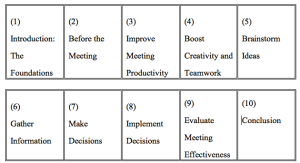“Nonlinear brainstorming techniques seem to suit many of the groups I facilitate. Is there an alternative to Mind Mapping that provides a flexible and visual process for sequencing information?”
3. Storyboarding
What Is Storyboarding?
Storyboarding is a nonlinear brainstorming technique that allows you to later arrange the ideas your group generates into a desired order or linear format. Many brainstorming techniques are designed to seek specific solutions to a given question or problem. Storyboarding differs from these techniques because it provides a process to visually manipulate brainstormed information into the most desirable order or format.
Examples of specific items that benefit from Storyboarding include agendas, presentations and speeches, training programs, and any other project that requires the ability to move items around and look at information simultaneously.
When to Use Storyboarding
- When you want to categorize and sequence ideas at a later time
- When you aren’t sure how to structure things from the start
- When brainstorming will identify only primary categories of information (Mind Mapping, technique 2, is a better choice when subcategories need to be identified)
How to Use Storyboarding
Before the Meeting
- After you select Storyboarding as the appropriate brainstorming technique, be sure that you bring the necessary materials to the meeting. These include markers or felt-tip pens and large cards (five by eight inches or larger) and tape or large sticky notes. If there is not an appropriate wall in the room to attach your cards or sticky notes, bring additional chart paper for this purpose.
During the Meeting
- Introduce Storyboarding as a brainstorming technique that allows the group to categorize and sequence information at a later time.
- As the group brainstorms, write each idea on a card or sticky note, and post it randomly on a wall or other predetermined location.
- When the brainstorming is finished, ask the group to help you sequence the items as appropriate based on the specific goal of the agenda item. See below for as a high-level example of Storyboarding, which uses the chapters of my upcoming book, Mission Critical Meetings: 81 Practical Facilitation Techniques, as its subject.
NOTE: It is a good idea to keep the Storyboard posted in a central location as a visual reminder of sequence. Make alterations if and when necessary.
OPTION: If your Storyboard requires more detail, you may use this same technique again for each category in your Storyboard.
Summary
Storyboarding is a brainstorming technique that provides a specific process for sequencing or ordering information.
Before the Meeting
- Bring markers or felt-tip pens and large cards (five by eight inches or larger) and tape or large sticky notes to the meeting.
During the Meeting
- Introduce Storyboarding as a brainstorming technique that will allow the group to categorize the information at a later time.
- As the group brainstorms, write each idea on a card and post it on the wall, chart, or predetermined area within the room.
- When the brainstorming is finished, ask the group to help you sequence the items as appropriate based on your agenda item goal.
- When the group agrees on a sequence, number each of the cards for documentation in the minutes of the meeting.
———————-
NOTE: If you would like to receive e-mail notification when I post additional techniques, please sign up through this link. http://eepurl.com/KILan You may unsubscribe at any time.
